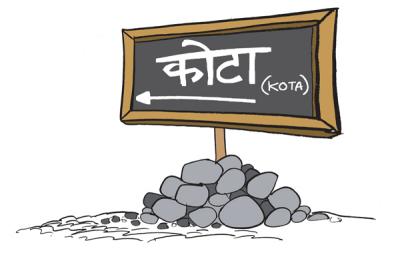My thoughts on education hubs and their role as income generating economic opportunities for nations often start with established success stories in Australia and Malaysia and more recently in the Middle Eastern kingdoms of Dubai and Qatar. But they quickly wind down towards a non-descript town in the arid Indian state of Rajasthan called Kota. You may have never heard of this town at all – most people have not.
The southwesterly winds that originate in the Arabian Sea bypass most of Rajasthan as the Aravali mountain range that could force them to drop moisture suffer from the misfortune of running parallel to the direction of the winds. Mountains, unlike factories cannot be erected – nor their direction changed. Rajasthan therefore had no rains and no future in India’s largely agricultural economy.
State sponsored industrialization turned Kota into a prosperous factory town. There were factories and ancillary units all over – producing everything from heavy machinery to industrial equipment. From across the country workers and supervisors and engineers and managers poured in to work and make a living. This gave Kota a kind of cosmopolitanism that is rare for small towns. New townships sprung up. Schools opened and cinemas mushroomed. Immigrants to this town had decent jobs; secure pay, well-behaved children, routine life and an expectation of comfortable retirement.
Kota’s industrial future, it turned out was unexpectedly short-lived. In the early nineties, policy makers in Delhi, India’s capital discovered that the government’s treasury was empty. That government-owned factories were producing stuff that even government did not want to buy. Nehru’s experiment in state-led industrialization had failed and free market capitalism deserved a try – so thought a set of bureaucrats charged with deciding India’s new economic paradigm. State’s brutal privatization process, suddenly, deformed a bright and bustling town into a town with no future. Workers were pensioned off. Factories closed or downsized. Townships bore a depressing look and fear of the unknown loomed on every face. Each one of those, who could find jobs – and a predictable future elsewhere – migrated.
In just over three decades government policies had made and unmade not only the fortunes of a town but also the destinies of countless individuals who lived in it.
Amongst those who chose to stay was a part-time private-tuition provider, once an able engineer; he had used fees from students to append his otherwise humble income. Yet he was a special teacher. One, he was disabled – his body wasted down the torso from a muscular atrophy and two – he did not teach regular school curricula – he prepared students for a tough entry examination required for admissions into India’s premier engineering schools – the IITs.
The students he tutored had done well. Indeed after he took up teaching full time, having no job or factory to go back to – allowed him to focus on his teaching – which flourished…and over a span of five years his IIT Preparatory Classes had enrolled and tutored over five hundred students to exceptional performance. The institute he founded, today teaches over five thousand students of which over five hundred gain entry into the IIT every year – an extremely high success rate. One teacher’s extraordinary success inspired several others to take up teaching for the same examination. There was, in any case, nothing much left to do in a town that was waiting to expire.
The collective success of several teachers motivated formal test preparatory businesses to setup shops. Over a period of five years as students poured in – more tuition centers emerged. Such has been the network effects of a completely uncoordinated, unplanned and unregulated activity that today, twenty years after it started, Kota has become home to over 250,000 students who come from all over to prepare for India’s competitive examinations.
That the efforts of a disabled part-time teacher in a dying town could result, not only, in the development of a vibrant multi-million dollar education industry but its rebirth – is intriguing.
Are there any lessons that Kota can hold to the world – particularly to educational hub aspirants like Mauritius?
Kota is a special kind of educational hub – an education hub without any universities and schools. Over one hundred and fifty institutes generate a combined annual income of US$120 million but some analysts estimate that their overall impact on the town’s economy is of the order of US$500 million if the incomes of numerous others service providers in taken into account. That is a kind of income small island states could aspire to add to their national wealth.
Kota is a city that may provide no lessons but it tells several stories. It tells us that people and businesses can succeed despite government policies. Large-scale state-led front-loaded capital investments are unnecessary. There are always niches large enough to exploit provided one cares to find them. That openness and innovation rather than coercive and counter-productive regulation works better. That people who stay back are not necessary those that have no choices but that staying back, itself, is their choice.
I had left Kota in the eighties bypassing the pain of a decaying city. I go there now with a sense of enthusiastic pride. But I go there for another reason – it is a city where I spent my childhood. It is a city where my friends live. It is a city where lives the man who could have left – but did not leave.
BEING REBORN : The death and reincarnation of an industrial town
- Publicité -
EN CONTINU ↻


